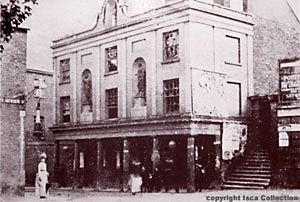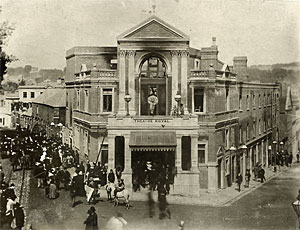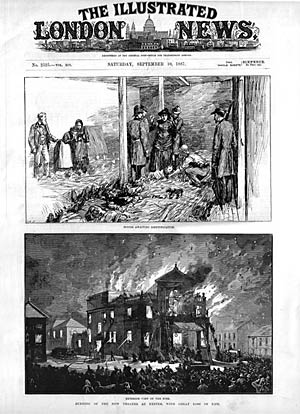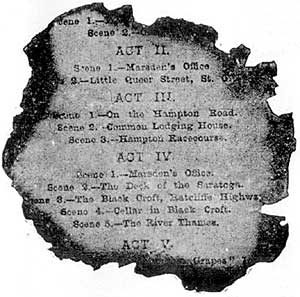
- Home
- Memories
- Scrapbook ▽
- Topics ▽
- People ▽
- Events
- Photos
- Site Map
- Timeline
Back to Theatres list
Illustrated Theatre Royal Fire
Theatre Royal Fire casualties list
Exeter has had a poor history of theatre safety, with three theatres destroyed by fire. In 1787, the New Theatre was built to replace by the Exeter Theatre in Waterbeer Street. It was built by Richard Hughes in what was then, the new development of Bedford Circus. It was situated on the site of what was, until recently, the old AA building of Fanum House. This was a great success with productions such as The Merchant of Venice with Edmund Keane in 1811. Then disaster struck - in 1820, the first of what would be three theatre fires in Exeter destroyed the building when a gas-lit chandelier, high in the roof, set fire to the rafters.
A new theatre named The Theatre Royal was built on the old site in West Southernhay in 1821, incorporating the colonnade of the old, New Theatre! This theatre entertained the people of Exeter until 1885 when another fire destroyed this building - this was pre-electricity with oxygen/hydrogen fuelled limelight, making for a very dangerous fire hazard. There were no casualties from the fire apart from a pig that belonged to a clown.
A hurried replacement, also called the Theatre Royal, was built at the top of Longbrook Street. With a capacity for 1,500, the theatre was built with little regard to fire safety - lessons had not been learned. The Exeter Theatre Company moved in during 1886. On the 5th September 1887, on the first night of a romantic comedy called Romany Rye, and with an audience of 800, a naked gas flame ignited some drapes in the fly's. Within moments, panic broke out as the flames spread. Despite the valiant efforts of the West of England Insurance Co., fire brigade, using the "Little West" fire engine, the flames spread through the building.
Robert Pople, landlord of the New London Inn was quickly on the scene with ladders to rescue the audience. He used the inn to shelter the victims, and the stables to lay out the dead.
There were 186 victims, many from the upper gallery who could not escape because of poorly designed exits - many victims were suffocated in the crush. Most were buried in a mass grave in Higher Cemetery and a memorial cross carved by Harry Hems placed over the spot.
This disaster was the worst theatre fire in British history, and soon, Parliament legislated to bring in stringent safety precautions in all British theatres, including the fire proof safety curtain. Exeter also gained its first electricity generating station which supplied the newly installed electric lighting system in the new Theatre Royal.
This
account of the fire is taken from a broadsheet by H P Such of
London, published the day after the fire.
A catastrophe exceeding in its disastrous results the calamity at the Opera Comique in Paris, and perhaps unparalleled in sad history of theatre fires happened in Exeter last night. The New Theatre Royal in that town burst into flames during the performance and in less than an hour the building was completely destroyed, and more than 150 persons perished. The suddenness of the outbreak, the rapidity with which the flames spread, and the lack of sufficient outlets combined to make the calamity all the more appalling and the deaths the more horrible. Notwithstanding the fact that the Exeter Theatre was a new one, opened last autumn, and that it's predecessor suffered a similar fate, it seems to have been full of awkward staircases amid passages and cramped exits, which soon became blocked; and more deaths are due to such causes than to the fire itself. The gallery, which was crowded, had only one exit, which soon became blocked, and the occupants of that part of the house were imprisoned in a furnace to be crushed suffocated, or burned to death.
THE FIRST ALARM
The play at the theatre was "Romany Rye" and the attendance was large. Not only were the pit and gallery crowded, but the stalls were well filled. At halfpast nine o'clock more went in, and then the popular parts were crammed. Up to this time, and until an hour later, not the least danger was apprehended. About ten minutes past ten the gipsy kidnapping scene had just taken place, and one of the actors was speaking the words, "It was a happy thing the policeman did not appear earlier, or he would have spoilt the intrigue," when the drop scene was discovered to fall rapidly. Indeed, had not Mr. Mouillot stepped back it would have alighted on his head. There was a loud titter among the audience who thought this was an accident. The conductor remarked "There's something up" and was about to fill the unconnected interval with a selection of music. The weight of the curtain when it fell warped the floor and rebounded, and the canvas was then puffed right out into the stalls and pit. At the same moment sparks and flames were seen. There were shrieks of "Fire! fire!" and a tremendous rush for the doors took place. One gentleman, who was almost the first to get into the street, and who had occupied a front seat in the stalls, states that the special exit door was open.
THE THEATRE A ROARING FURNACE
>Within three minutes the theatre was a roaring furnace. Flames shot up through the roof over the stage and dense smoke poured forth from every window. The roar of fire, the shrieks of women, despairing shouts of men, both in the streets and on the balconies, made up an awful scene. Women threw themselves into the streets from side balconies, quite a distance of 40 feet, and the flat lead roof over the portico was crowded with human beings crying for help. Meanwhile the fire had swept with amazing rapidity from the stage, and tongues of flame licked and scorched those on the balconies. There seemed to be no choice between a horrible death and becoming a mangled corpse on the pavement below, which was already covered with the blood of those who had cast themselves despairingly down. Soon after the outbreak the City Fire Brigade were on the spot, but the water they poured on the fire was absolutely without effect.
THE SCENE IN THE GALLERY
The gallery was the only part of the theatre from which there was but one exit, and it was here that the terrible loss of life is believed principally to have occurred. A great many managed to reach the New North Road by the ordinary stairway; others escaped to the roof over the front balcony of the theatre, and were implored by a hundred voices not to jump into the street. They were in a perilous position, for the fire escape, which was said to be coming, had not arrived, and the flames were fast approaching them. But other poor creatures there were whose fate was a harder one. Seated in the front row and body of the gallery, they found upon the first alarm a stuggling mass between them and the doorway or windows and the fire at their backs. The shrieks, as described by one or two who did get outside were heartrending. Blinded and nearly stifled with smoke, the unfortunate people could perceive no chance of escape, and its believed that over 90 lives were lost here.
OVERTAKEN BY THE ADVANCING FLAMES
It is almost needless to say that the utmost panic prevailed throughout the theatre, and the terror and bewilderment was intensified a hundredfold at those points where egress seemed impossible. The occupants of the pit gained the open air after a desperate struggle, in which many of them sustained grave injuries, but even the most violently contused ones have cause to be thankful that they escaped with their lives. But to gain anything like a fair conception of the dreadful struggle for life which took place in the gallery, one has to picture a panic stricken throng of men, women, and children pushing or forcibly impelled towards the single doorway - the only exit the gallery seemed to have afforded - and followed by the tongues of flame, momentarily increasing until at last the outer fringe of the mass was overtaken by it. This contact of the flames with the people, it must be borne in mind, happened only a few minutes after the discovery of the outbreak and within but little more time than it takes to write the fact the majority of the people whose corpses are now laid out have breathed their last. As for those who escaped from this furnace they did so either over the bodies of their more unfortunate companions or through the windows. When the latter alternative was adopted the jumpers often flew from one death to another almost equally horrible whilst others sustained fractures to their limbs. The great mass of men, women and children in the gallery were, however wedged into an almost almost immovable mass and the advancing flames roasted then to death.
THE SEARCH FOR THE DEAD
There was a band of willing workers aiding the medical gentlemen as each case was taken into the yard, but unhappily in most of them human aid was of no avail. The yard was kept as free from crowding as possible, but some anxious friends of victims who pleaded for admission were allowed to enter, and now and then a wail of lamentation announced the discovery of a dead relative. A carriage shed in which bodies were placed soon became too limited and the stables has to be utilized. A number of town councillors who were present ordered shell coffins to be made at once, and as they were completed the bodies were one by one removed to the public rooms there they await recognition in cases where they had not been already recognized. The strong men who were so willing in assisting in removing the bodies, sickened over their deadly task, and everyone was horrorstricken at being hardly able to realize the awful extent of the calamity.
WHAT WAS THE CAUSE OF THE FIRE
The rapidity with which the fire spread is the subject of general remark. Within little more than five minutes of the alarm being given all the roof of the theatre was ablaze. One of the stage carpenters says that the fire arose through some gauge used in the scenery catching fire and like lightening, communicated with the scene lift. The latter was unusually crowded, not only with the heavy scenery in "The Romany Rye" but owing to the preparations being pushed forward at the same time for the pantomime season, the scenery for which was in an advanced state. When the alarm was given there was nearly 900 people in the theatre, 600 in the pit, 191 in the gallery, and the rest in the upper parts of the house and among the company and the theatre attendants.
MESSAGE FROM THE QUEEN
The following message has been received from the Home Secretary on behalf of the Queen:- "By command of her Majesty, I ask you to express her Majesty's deep sympathy with the injured in last night's accident and with the families of those who have been killed. - Henry Matthews, Home Sec."
The broadsheet continued with a six verse lament.
Sources: A facsimile from the The Devon Library Service for the text of the article. © 2005 David Cornforth - not to be used without permission
 The
first Theatre Royal that was destroyed in 1885.
The
first Theatre Royal that was destroyed in 1885.
 The burnt out Theatre Royal of
1887.
The burnt out Theatre Royal of
1887. The front page of the Illustrated London News from September 1887.
The front page of the Illustrated London News from September 1887.
 Burnt programme for Romany Rye.
Burnt programme for Romany Rye.
│ Top of Page │